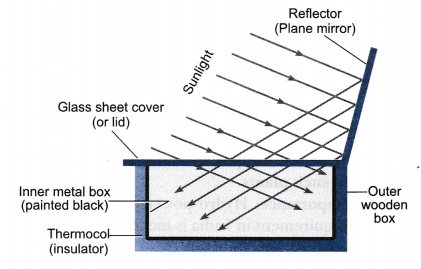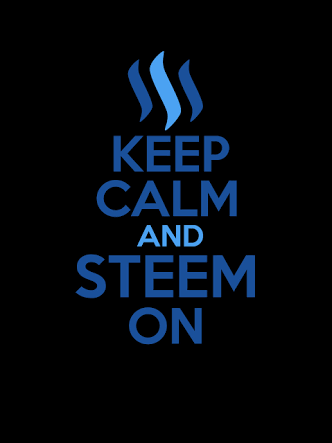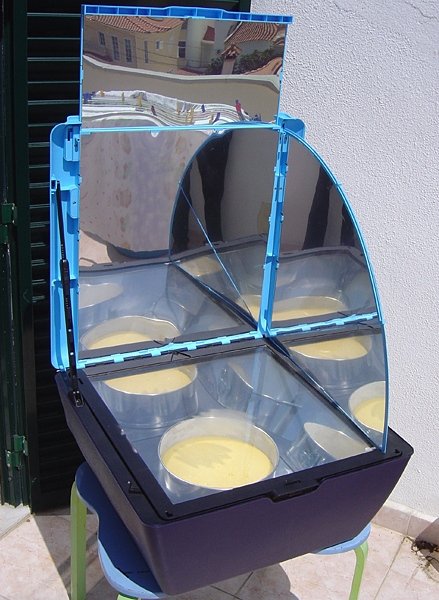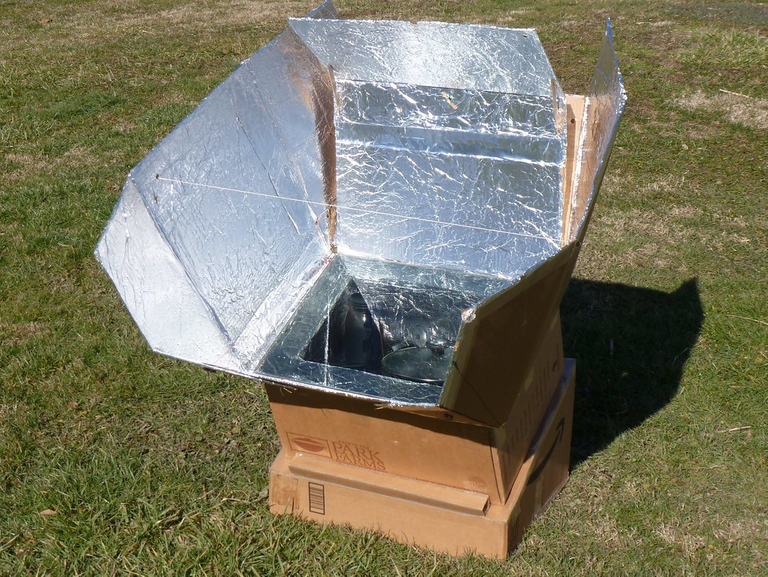Solar cooker is a device that uses sunlight for energy. They do not use fuel and practically it does not cost anything to run them. They also help prevent slow deforestation and desertification. Another advantage of cooking over solar is that unlike cooking with fire, solar cookers do not pollute the air. Solar cookers are also sometimes used for cooking outdoors, especially when it is risky to use a fire or there is no fuel. Solar cooker is very useful. It is a renewable source of energy.

Source
There are many different design styles for solar cookers, but they are all common in which no fossil fuels are used and food is made using only solar energy.
Solar cookers were long considered too slow and impractical for cooking food; It was seen at middle school science fairs and the Third World Disaster Relief. But recent advances in materials technology have significantly reduced the time it takes to prepare food with solar cookers, making it a serious competitor to traditional ovens.
How Solar Cooking Work?
Solar energy based technology can improve the lives of families everywhere. Understanding the different physics helps new solar cooks to understand what it takes to harness the power of the sun.
A solar cooker allows UV light rays to enter and then converts them into long infrared light rays that cannot exit. The energy of infrared radiation is right for making water, fat and protein molecules in food.
It is not the heat of the sun that cooks food, nor is it the outside ambient temperature, although it may affect the rate or time required for cooking to some extent, but it is the rays of the sun that heat the food. Are converted into energy; And this heat energy is maintained by utensils and food through a cover or lid.

Source
This is the same way a greenhouse retains heat. An effective solar cooker will use the sun's energy to heat a cooking pot and efficiently retain energy (heat) for maximum cooking effectiveness.
The working of solar cooker can be explained through the following map of the process.
First, you will need a black lid pot with a lid. It can be a pot resembling a cast iron Dutch oven, a black enameled roasting pan such as a chicken or turkey roaster, or any pot that you can black out from the outside with non-toxic, weatherproof paint. The black surface becomes very hot; They heat more quickly than shiny surfaces.
You will then need to obtain a clear transparent wrapper such as a large glass bowl or a durable plastic oven cooking bag. This will be used for heat retention and will also allow the sun's rays to be able to enter the black cooking utensils and food, thus raising the cooking temperature and preventing heat escaping out.
Next you will need a material that reflects excess sunlight towards the cooking device to focus the sun's rays. This is usually accomplished by some form of reflective surface such as mirrors, aluminum foil and buffed tin or sheet metal. With the help of a reflective surface, you can increase the temperature and cook food faster.
For maximum efficiency it is necessary to “track” the sun, or in other words adjust your solar cooker in such a way that it can better store and absorb the sun’s rays.
This does not mean that you should constantly stand near the solar cooker for the entire cooking period. But the angle and direction are adjusted every time or every set period, such as every one to two hours.
Parts of the solar cooker
Most solar cookers have three main components, or you can say three main principles for effective solar cooking; These are
Concentration (reflection)
Absorption (ability to attract or hold heat)
Retention (means or ability to retain heat)
Sun rays are most often characterized by panels, petals, and surfaces that can focus rays of light (UV) at a point or concentration. These reflective panels are usually made of shiny and reflective material. Due to the substances used in their manufacture, such as silver, chromium, and aluminum. It is a means for concentrating sun rays that may take longer to heat objects or surfaces, thus most solar cookers are manufactured with reflector panels to speed up the process.
Absorption of the sun's energy (heat) in solar cooking is best achieved when the surface is black in color, thus the most common solar oven interiors are usually black in color.
Darker colors absorb heat, while lighter colors do not absorb heat well. And some colors may reflect the sun's energy, such as silver for example. In general, the best cook ware for solar cooking is the dark, thin variety because it absorbs heat (energy) well; And because it is thin, it can transfer heat to food more quickly and evenly.
Retention is the ultimate principle in solar cooking. If the solar cooker is not well insulated and if it does not have a cover, or lid, all the concentrated heat (energy) and absorbed heat will drain out quickly. A solar cooker must have a means to "trap" or hold the concentrated heat to "build" to a sufficiently high level to be able to cook effectively.
Advantages of a Solar Cooker
There is no need of gas or kerosene, electricity, coal or wood for cooking.
There is no need to spend on fuel, because solar power is available free.
Food cooked in solar cooker is nutritious. About 10–20% protein retention is higher than in traditional cooking. Vitamin thiamine retention is about 20 to 30% higher, while vitamin A is retained 5 to 10% more when food is cooked in a solar cooker.
Solar cooking is pollution free and safe.
Disadvantages of a Solar Cooker
Adequate sunlight is required for cooking.
It takes longer to cook food than traditional cooking methods.
Conclusion
We can bake, stew, steam, fry and braise any kind of food using a solar cooker, but using sunlight instead of gas or electricity.
The box cooker is a simple type of solar cooker. Probably of 3 to 5 feet (1 to 1.5 meters), this is essentially a sun-powered oven - an enclosed box that heats and seals in that heat. At its most basic, the box cooker consists of an open box, which is black on the inside, and a piece of glass or transparent plastic on the top.
@orion7




This post earned a total payout of 1.690$ and 1.271$ worth of author reward which was liquified using @likwid. To learn more.
Nice post! Any examples or links to both commercial or DIY products or plans would be a nice addition to the post. You might also want to include tags for #palnet, #marlians, #neoxian, #diy, and #build-it to your list. That can earn you legitimate extra coin :)
Thanks for nice suggestions.
Congratulations @orion7! You have completed the following achievement on the Steem blockchain and have been rewarded with new badge(s) :
You can view your badges on your Steem Board and compare to others on the Steem Ranking
If you no longer want to receive notifications, reply to this comment with the word
STOPTo support your work, I also upvoted your post!
Vote for @Steemitboard as a witness to get one more award and increased upvotes!
You got a 40.00% upvote from @joeparys! Thank you for your support of our services. To continue your support, please follow and delegate Steem power to @joeparys for daily steem and steem dollar payouts!
All @joeparys upvotes will be suppressed until he stop posting this from his bot.
To continue your support, please follow and delegate Steem power to @joeparys for daily steem and steem dollar payouts!Hello. Currently there are a lot of curation groups and whales curating amazing content, there's no need to buy votes. The downvote you received is to discourage the buying of votes from bidbots. We kindly invite you to join us on the #NewSteem attitude, where good content receives votes and the organic content get the most attention. Buying votes hurts you, other authors and the Steem Ecosystem in general, please don't do it.